小学英语集体备课记录
- 格式:doc
- 大小:71.00 KB
- 文档页数:18
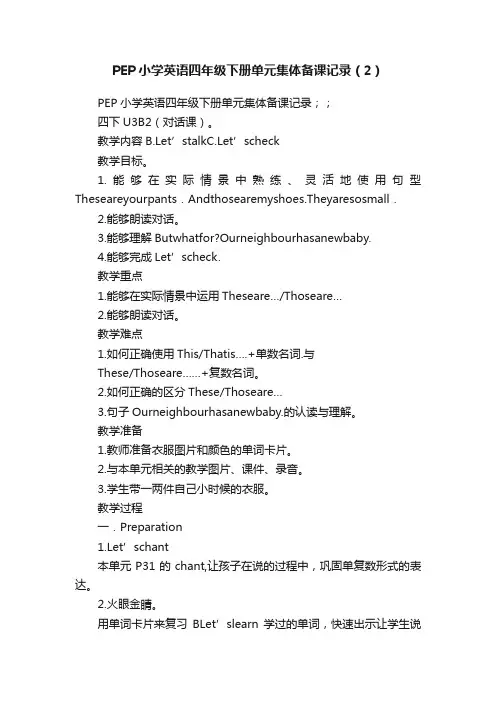
PEP小学英语四年级下册单元集体备课记录(2)PEP小学英语四年级下册单元集体备课记录;;四下U3B2(对话课)。
教学内容B.Let’stalkC.Let’scheck教学目标。
1.能够在实际情景中熟练、灵活地使用句型Theseareyourpants.Andthosearemyshoes.Theyaresosmall.2.能够朗读对话。
3.能够理解Butwhatfor?Ourneighbourhasanewbaby.4.能够完成Let’scheck.教学重点1.能够在实际情景中运用Theseare…/Thoseare…2.能够朗读对话。
教学难点1.如何正确使用This/Thatis….+单数名词.与These/Thoseare……+复数名词。
2.如何正确的区分These/Thoseare…3.句子Ourneighbourhasanewbaby.的认读与理解。
教学准备1.教师准备衣服图片和颜色的单词卡片。
2.与本单元相关的教学图片、课件、录音。
3.学生带一两件自己小时候的衣服。
教学过程一.Preparation1.Let’schant本单元P31的chant,让孩子在说的过程中,巩固单复数形式的表达。
2.火眼金睛。
用单词卡片来复习BLet’slearn学过的单词,快速出示让学生说单词。
3.FreeTalk。
(借助课件展示各种颜色的衣服及放的位置)TLookatmypants,whatcolourarethey?Theyare...TLookatmyshoes,whatcolourarethey?Theyare...TWhereareyourshoes/pants/socks?Theyare…二.Presentation情景呈现1.教授“Theseareyourpants.”与“Thosearemyshoes.”的教学。
(1).教师拿出一件skirt和一件dress(学生小时候的)介绍说Thisisyourskirtandthatisyourshirt。
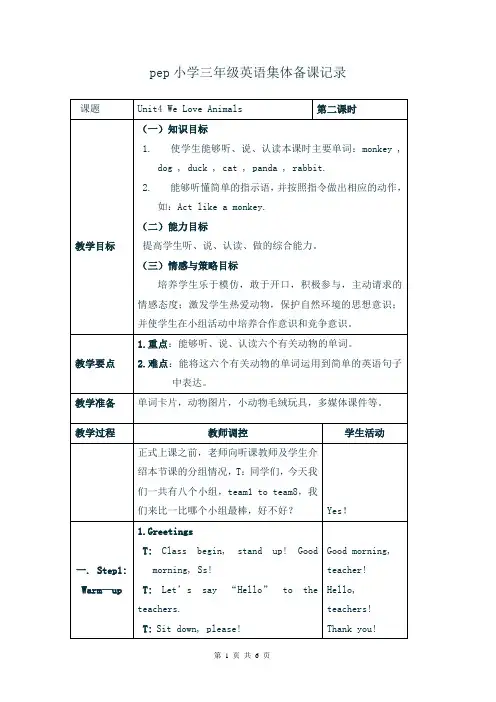
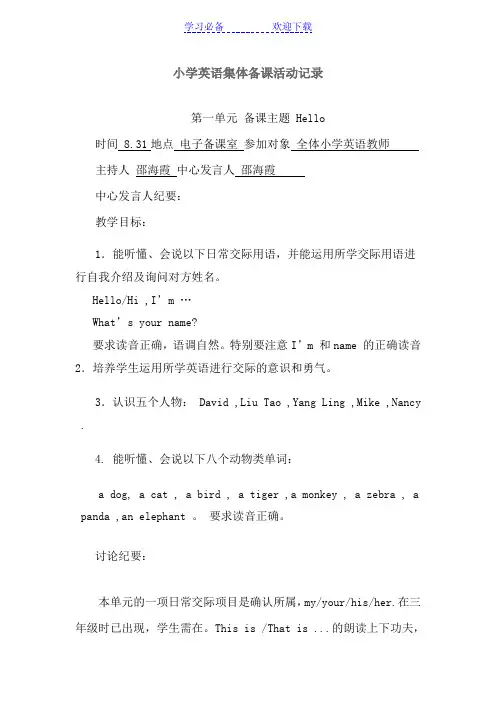
小学英语集体备课活动记录第一单元备课主题 Hello时间 8.31地点电子备课室参加对象全体小学英语教师主持人邵海霞中心发言人邵海霞中心发言人纪要:教学目标:1.能听懂、会说以下日常交际用语,并能运用所学交际用语进行自我介绍及询问对方姓名。
Hello/Hi ,I’m …What’s your name?要求读音正确,语调自然。
特别要注意I’m 和name 的正确读音2.培养学生运用所学英语进行交际的意识和勇气。
3.认识五个人物: David ,Liu Tao ,Yang Ling ,Mike ,Nancy .4. 能听懂、会说以下八个动物类单词:a dog, a cat , a bird , a tiger ,a monkey , a zebra , a panda ,an elephant 。
要求读音正确。
讨论纪要:本单元的一项日常交际项目是确认所属,my/your/his/her.在三年级时已出现,学生需在。
This is /That is ...的朗读上下功夫,并带上肢体语言而且要让学生明白your/you的区别。
在训练时,要生积极练说,练多了就熟练地会说了。
刘星辉:在本节课设计中,为了培养学生的主体意识,让学生积极主动地学习设计者尽力做到了尊重和发展学生的主体意识和主动精神。
我认为本节课所需注意的是,由于时间有限,有些活动可草草收场,学生的能力不能得到充分发挥,希望在教学中能够得到改进。
牛萍:本节课的内容设计新颖合理,思路清新,教学目标明确,重点突出,能充分反映出本课所教内容的重点,也能抓住主要内容进行教学。
教练的引进结合,可以让学生更牢固地掌握新知。
综合修改意见:在教学中,要倡导学生积极参与,让学生在学习过程中不仅要建构知识,提高语言能力,而且通过感知,体验,实践,参与和合作探究等活动方式,完成任务和实现目标。
设计时要以学生为中心,根据学生的特点,兴趣,爱好来选择设计,让每个学生参与到活动中,从而表现自我,发展了学生的个性。
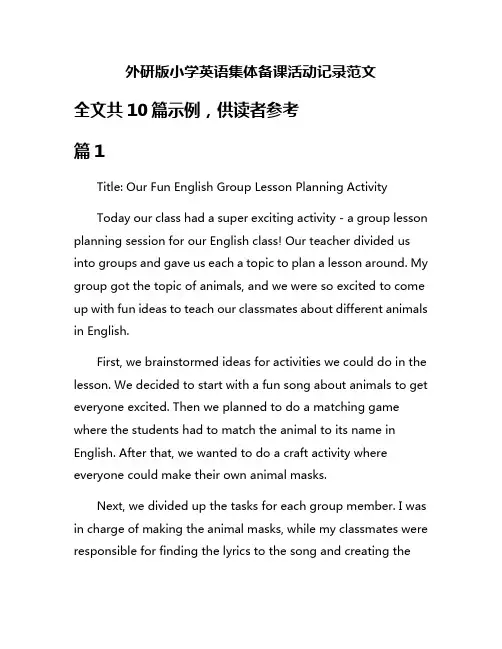
外研版小学英语集体备课活动记录范文全文共10篇示例,供读者参考篇1Title: Our Fun English Group Lesson Planning ActivityToday our class had a super exciting activity - a group lesson planning session for our English class! Our teacher divided us into groups and gave us each a topic to plan a lesson around. My group got the topic of animals, and we were so excited to come up with fun ideas to teach our classmates about different animals in English.First, we brainstormed ideas for activities we could do in the lesson. We decided to start with a fun song about animals to get everyone excited. Then we planned to do a matching game where the students had to match the animal to its name in English. After that, we wanted to do a craft activity where everyone could make their own animal masks.Next, we divided up the tasks for each group member. I was in charge of making the animal masks, while my classmates were responsible for finding the lyrics to the song and creating thematching game. We worked together to make sure everything was ready for our lesson.On the day of the lesson, we were all nervous but excited to teach our classmates. We started with the song, and everyone sang along enthusiastically. Then we moved on to the matching game, which was a big hit with the students. They were so engaged and excited to learn the names of the animals in English.Finally, we did the craft activity, and everyone had so much fun making their animal masks. The lesson flew by, and before we knew it, it was over. We were so proud of ourselves for planning and executing such a fun and educational lesson.Overall, our group lesson planning activity was a huge success. We learned a lot about teamwork, creativity, and how to make learning English fun for our classmates. We can't wait to do it again!篇2Our English class had a really fun activity today - group lesson planning! It was so cool because we got to work together and come up with all kinds of fun ideas for our lessons.First, we split up into groups of four. My group had me, Lily, Tom, and Sarah. We all had to brainstorm ideas for different activities we could do in our English classes.Lily suggested we could do a role play activity where we acted out a dialogue in English. Tom thought it would be fun to play a game where we had to match English words with pictures. Sarah had the idea of making English flashcards with pictures on one side and words on the other.After we came up with our ideas, we had to choose one to present to the whole class. We decided on the role play activity because we thought it would be the most fun.When it was our turn to present, we acted out our dialogue in front of the class. It was a bit nerve-wracking, but everyone loved it and thought it was really funny.Overall, the group lesson planning activity was a blast! We all had a great time working together and coming up with creative ideas for our English classes. I can't wait to see what other fun activities we come up with in the future!篇3Title: Our Fun English Lesson Prep ActivityHey everyone! Today, our class had a super exciting English prep activity for our upcoming lesson. We all gathered together and brainstormed some awesome ideas to make our lesson fun and interactive.First, we decided to start off with a fun game of Pictionary. We divided into teams and took turns drawing different English words on the board. It was so much fun guessing what each other was drawing and practicing our vocabulary at the same time.Next, we worked on creating some flashcards for new words we will be learning in our next lesson. We each picked a word and decorated our flashcards with colorful drawings and stickers. It was great to see everyone using their creativity to make learning English even more enjoyable.After that, we practiced our pronunciation by singing along to some popular English songs. We chose our favorite songs and sang our hearts out, trying our best to pronounce each word correctly. It was a hilarious and entertaining way to improve our English skills.To wrap up our prep activity, we played a game of charades. We acted out different English phrases and words, challenging each other to guess what we were trying to communicate. It wasa great way to practice our speaking and listening skills in a fun and engaging way.Overall, our English lesson prep activity was a huge success. We had a blast working together as a team, being creative, and playing fun games to improve our English skills. We can't wait to see how these activities will help us in our upcoming English lesson. Go team English!篇4Title: Our Awesome Collective Lesson Planning ActivityHello everyone! I'm so excited to share with you all about our recent collective lesson planning activity. It was super fun and we came up with so many great ideas for our English lessons.First, we all gathered in the meeting room and introduced ourselves. We laughed and joked around, which made everyone feel comfortable and excited to work together. Then, we started brainstorming ideas for our lessons. We shared our favorite activities, games, and songs that we thought would be perfect for our students.Next, we divided into groups and started planning our lessons. We worked together to come up with fun and engaging activities that would help our students improve their English skills. Some of the ideas we came up with were role-playing games, vocabulary quizzes, and group projects.After we finished planning our lessons, we all came back together and presented our ideas to the group. Everyone was so supportive and encouraging, and we gave each other feedback to make our lessons even better. It was amazing to see how creative everyone was and how much effort we put into making our lessons awesome.Overall, our collective lesson planning activity was a big success. We all had a great time working together and coming up with fun and engaging ideas for our English lessons. I can't wait to see how our students react to the lessons we planned, and I'm looking forward to more activities like this in the future. Thanks for reading about our awesome experience!篇5Title: Our Fun English Lesson Preparation ActivityHi everyone! Today, we had a super fun activity in our English class. We did a group lesson preparation activity, just like real teachers do! It was so exciting and we learned a lot too.First, we divided into groups of four, and each group was given a topic to prepare a lesson on. My group got the topic of animals. We brainstormed and came up with ideas on what to teach, like different animal names, sounds they make, and where they live.Next, we made our lesson plan. We decided to start with a song about animals to get everyone excited. Then, we would introduce the names of different animals in English and teach the sounds they make. We also prepared some fun activities like a matching game and a quiz to make the lesson more interactive.After that, we practiced our lesson with our group members. We took turns being the teacher and the students, and we gave each other feedback to make our lesson even better. It was so much fun pretending to be a teacher!Finally, it was time to present our lesson to the class. We set up our materials and confidently taught our classmates about animals. Everyone had so much fun singing the song and playing the games. We all learned a lot and had a great time.In conclusion, our group lesson preparation activity was a huge success. We learned how to work together as a team, plan a lesson, and teach it to others. It was an awesome experience and we can’t wait to do it agai n. English class is the best!篇6Hello everyone! Today I'm going to share with you our group lesson planning activity for the English class. We used the Oxford primary school edition textbook for our lesson.First, we started by discussing the objectives of the lesson. We wanted the students to be able to identify and use different types of food vocabulary in English. We also wanted them to practice speaking and listening skills through various activities.Next, we looked at the different sections of the textbook that we could use for the lesson. We decided to focus on the unit about food and drinks, as it provided a good range of vocabulary and activities for the students.Then, we brainstormed some ideas for activities that could be included in the lesson. We came up with a vocabulary matching game, a role play activity where students would pretend to order food in a restaurant, and a listening exercisewhere students would listen to a dialogue and answer questions about it.After that, we divided the tasks among ourselves. One teacher would lead the vocabulary game, another teacher would facilitate the role play activity, and the third teacher would oversee the listening exercise.During the lesson, we encouraged the students to participate actively and engage with the activities. We provided support and guidance where needed, and praised their efforts and progress throughout the lesson.Overall, the lesson was a success! The students were able to learn new vocabulary, practice their speaking and listening skills, and have fun at the same time. We all felt proud of the work we had done together as a team. Can't wait for our next group lesson planning activity!篇7Our English lesson is super fun today! We had a group lesson planning activity and it was really cool.First, our teacher split us into small groups and gave each group a topic to plan a lesson on. My group got the topic of animals, which was awesome because I love animals!We sat together and brainstormed ideas for the lesson. We decided to start with a fun song about animals, then we would do a matching game with pictures of different animals and their names. After that, we planned to watch a short video about animals in the wild.We also came up with some questions to ask the class after the video, like "What is your favorite animal?" and "Have you ever seen this animal before?". We thought it would be a great way to get everyone involved and practicing their English.Once we had our lesson plan ready, we presented it to the class. Everyone loved it and had so much fun participating in the activities we had planned. It was great to see everyone engaged and excited to learn.Overall, the group lesson planning activity was a big success. We all worked together and came up with a fantastic lesson that helped us learn English in a fun and interactive way. I can't wait for the next one!篇8Title: Our Fun and Productive Collective Lesson Planning ActivityHi everyone! Today we had a really fun and productive collective lesson planning activity for our English class. We all got together to brainstorm ideas and come up with exciting activities for our upcoming lessons. Here's a recap of what we did:First, we started by sharing our ideas for the lesson topics. We talked about different themes like animals, food, and sports. It was so cool to hear everyone's thoughts and suggestions!Next, we split into groups to plan out the activities for each lesson. We had a group for vocabulary games, a group for reading exercises, and a group for listening activities. It was really fun working together and coming up with creative ideas.We also discussed how to incorporate technology into our lessons. We talked about using interactive whiteboards, educational apps, and online resources to make our lessons more engaging and interactive.After that, we put together a schedule for the next few weeks. We planned out which lessons we would cover each day and what materials we would need. It was great to have everything organized and ready to go!Overall, our collective lesson planning activity was a huge success. We all had a blast working together and coming up with fun and exciting activities for our English class. I can't wait to see how our lessons turn out!Until next time, happy teaching!篇9Title: Our Fun English Lesson Planning ActivityHi everyone! Today we had a really cool English lesson at school. Our teacher organized a group lesson planning activity for us to work together and come up with fun and exciting ideas for our English lessons. It was so much fun!First, we all sat together in a circle and our teacher explained the activity to us. She told us that we were going to work in groups to plan an English lesson for the class. Each group had to come up with a different theme for their lesson, like animals, colors, or sports. We were allowed to use flashcards, songs, games, or any other fun activities to teach the class.My group decided to plan a lesson about animals because we all love animals. We thought of using animal flashcards, singing animal songs, and playing a game where we had toguess the animal sound. It was so much fun brainstorming ideas with my friends!After we planned our lessons, each group presented their ideas to the class. We showed our animal flashcards, sang our animal song, and played the animal sound guessing game. The class loved it! Everyone was laughing and having a great time.Overall, the English lesson planning activity was a huge success. We all learned how to work together as a team, come up with creative ideas, and present our work to the class. It was a great way to practice our English skills while having fun. I can't wait for our next group activity!篇10Our English Class Collective Lesson Planning ActivityToday, our class had a really fun and exciting English lesson! Our teacher told us that we were going to do a collective lesson planning activity to help us learn more about teamwork and collaboration. We were so excited because we love working together as a team.First, we all sat in a circle and our teacher explained to us that we were going to plan a lesson together. She divided us intodifferent groups and assigned each group a different task. Some of us were in charge of choosing the topic for the lesson, some were responsible for coming up with the activities, and others had to prepare the materials needed.We worked really well together and everyone had great ideas. We decided to have a lesson about animals because we all love animals. We planned to learn different animal names, sounds they make, and where they live. We also prepared some fun games and activities like Animal Charades and a matching game with animal pictures and names.After we finished planning our lesson, we presented it to the class. We took turns explaining each activity and everyone was so engaged and excited. We had so much fun learning and playing together.Overall, this collective lesson planning activity was a huge success! We learned how to work as a team, communicate effectively, and be creative. We can't wait to have more lessons like this in the future. English class is always so much fun!。
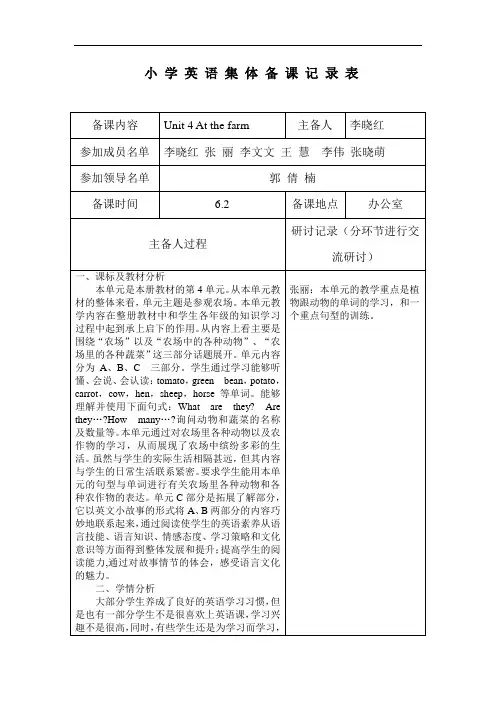
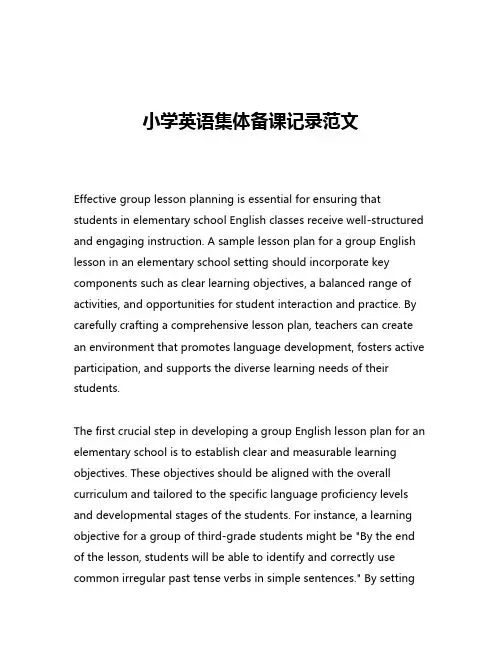
小学英语集体备课记录范文Effective group lesson planning is essential for ensuring that students in elementary school English classes receive well-structured and engaging instruction. A sample lesson plan for a group English lesson in an elementary school setting should incorporate key components such as clear learning objectives, a balanced range of activities, and opportunities for student interaction and practice. By carefully crafting a comprehensive lesson plan, teachers can create an environment that promotes language development, fosters active participation, and supports the diverse learning needs of their students.The first crucial step in developing a group English lesson plan for an elementary school is to establish clear and measurable learning objectives. These objectives should be aligned with the overall curriculum and tailored to the specific language proficiency levels and developmental stages of the students. For instance, a learning objective for a group of third-grade students might be "By the end of the lesson, students will be able to identify and correctly use common irregular past tense verbs in simple sentences." By settingexplicit learning goals, teachers can ensure that the lesson activities and assessments are purposeful and effectively support student learning.Once the learning objectives have been determined, the next step is to carefully structure the lesson plan to include a variety of engaging activities that cater to different learning styles and preferences. A well-designed group English lesson should incorporate a balance of teacher-led instruction, collaborative group work, and individual practice opportunities. For example, the lesson might begin with a warm-up activity, such as a vocabulary review game, to activate prior knowledge and capture students' attention. This could be followed by a brief teacher-led presentation introducing the target grammar or language concept, accompanied by visual aids and examples.To reinforce the new learning and provide opportunities for active engagement, the lesson plan should then include small-group or pair-work activities. These activities might involve tasks such as information-gap exercises, where students work together to exchange information and complete a shared objective, or role-playing scenarios that allow them to apply the target language in a meaningful context. By fostering collaborative learning, students can develop essential communication skills, build confidence, and deepen their understanding of the material.In addition to the interactive group activities, the lesson plan should also incorporate individual practice opportunities, such as written exercises or independent reading and writing tasks. These activities allow students to consolidate their learning, receive personalized feedback, and demonstrate their mastery of the target language skills. For instance, students might be asked to write a short paragraph using the irregular past tense verbs they have learned, or to read a brief passage and answer comprehension questions.To ensure that the lesson plan is responsive to the diverse needs of the students, it is important to incorporate differentiated instruction strategies. This might involve providing tiered or scaffolded activities, offering choice in the type of tasks students complete, or adapting the level of support and guidance based on individual student needs. By differentiating the instruction, teachers can ensure that all students, regardless of their language proficiency or learning styles, have opportunities to engage with the content and demonstrate their learning.Throughout the lesson, the teacher should also incorporate formative assessment techniques to monitor student progress and adjust the instruction as needed. This might involve circulating during group or individual activities to observe student performance, asking targeted questions to gauge understanding, or collecting brief written responses or exit tickets to identify areas that requireadditional support. By regularly assessing student learning, teachers can make informed decisions about pacing, provide timely feedback, and adapt the lesson plan to address any gaps or misconceptions.Finally, the group English lesson plan should include a well-structured conclusion that reinforces the key learning objectives and provides opportunities for students to reflect on their progress. This might involve a whole-class discussion, a summarizing activity, or an assignment that encourages students to apply the target language in a new context. By ending the lesson with a sense of closure and a clear connection to the learning goals, teachers can help students consolidate their understanding and prepare for future lessons.In conclusion, a comprehensive and well-designed group English lesson plan for an elementary school setting is essential for delivering effective and engaging instruction. By establishing clear learning objectives, incorporating a balance of teacher-led, collaborative, and independent activities, differentiating instruction to meet diverse needs, and regularly assessing student progress, teachers can create a learning environment that supports language development, fosters active participation, and sets students up for long-term success in English language learning.。
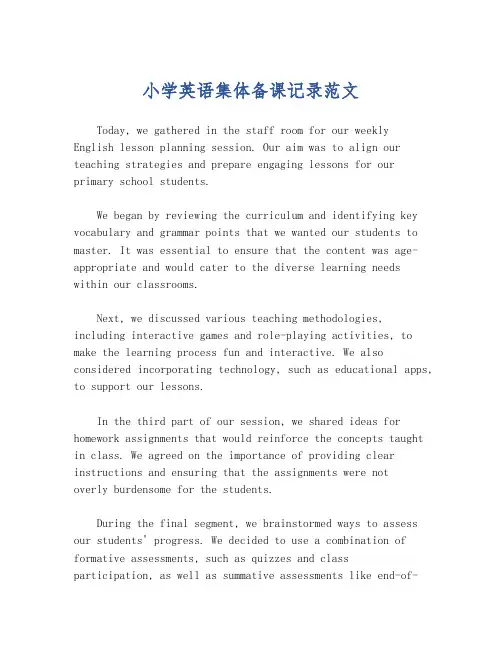
小学英语集体备课记录范文Today, we gathered in the staff room for our weeklyEnglish lesson planning session. Our aim was to align our teaching strategies and prepare engaging lessons for our primary school students.We began by reviewing the curriculum and identifying key vocabulary and grammar points that we wanted our students to master. It was essential to ensure that the content was age-appropriate and would cater to the diverse learning needs within our classrooms.Next, we discussed various teaching methodologies, including interactive games and role-playing activities, to make the learning process fun and interactive. We also considered incorporating technology, such as educational apps, to support our lessons.In the third part of our session, we shared ideas for homework assignments that would reinforce the concepts taught in class. We agreed on the importance of providing clear instructions and ensuring that the assignments were notoverly burdensome for the students.During the final segment, we brainstormed ways to assess our students' progress. We decided to use a combination of formative assessments, such as quizzes and classparticipation, as well as summative assessments like end-of-unit tests.It was a productive meeting, and we left with a clear plan for the week ahead. We are confident that our collaborative efforts will lead to a successful and enjoyable learning experience for our students.。
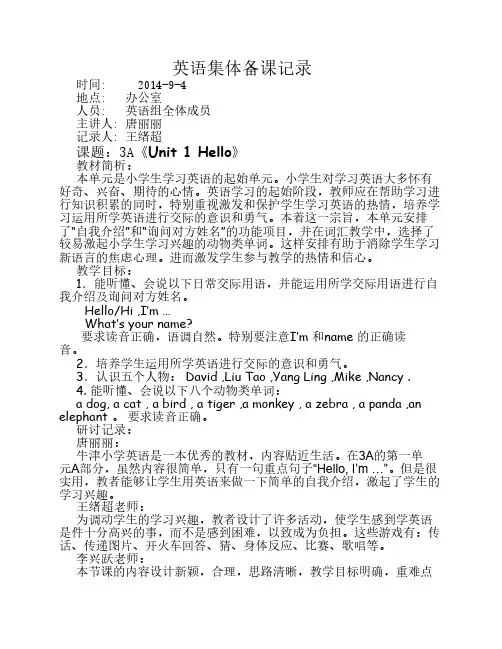
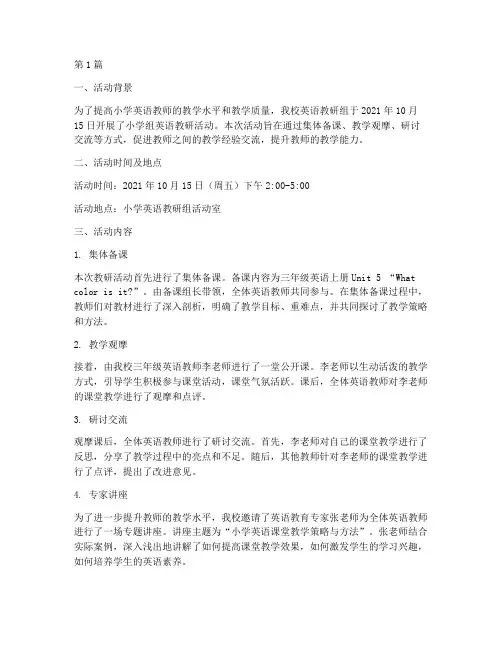
第1篇一、活动背景为了提高小学英语教师的教学水平和教学质量,我校英语教研组于2021年10月15日开展了小学组英语教研活动。
本次活动旨在通过集体备课、教学观摩、研讨交流等方式,促进教师之间的教学经验交流,提升教师的教学能力。
二、活动时间及地点活动时间:2021年10月15日(周五)下午2:00-5:00活动地点:小学英语教研组活动室三、活动内容1. 集体备课本次教研活动首先进行了集体备课。
备课内容为三年级英语上册Unit 5 “What color is it?”。
由备课组长带领,全体英语教师共同参与。
在集体备课过程中,教师们对教材进行了深入剖析,明确了教学目标、重难点,并共同探讨了教学策略和方法。
2. 教学观摩接着,由我校三年级英语教师李老师进行了一堂公开课。
李老师以生动活泼的教学方式,引导学生积极参与课堂活动,课堂气氛活跃。
课后,全体英语教师对李老师的课堂教学进行了观摩和点评。
3. 研讨交流观摩课后,全体英语教师进行了研讨交流。
首先,李老师对自己的课堂教学进行了反思,分享了教学过程中的亮点和不足。
随后,其他教师针对李老师的课堂教学进行了点评,提出了改进意见。
4. 专家讲座为了进一步提升教师的教学水平,我校邀请了英语教育专家张老师为全体英语教师进行了一场专题讲座。
讲座主题为“小学英语课堂教学策略与方法”。
张老师结合实际案例,深入浅出地讲解了如何提高课堂教学效果,如何激发学生的学习兴趣,如何培养学生的英语素养。
5. 教学反思最后,全体英语教师针对本次活动进行了教学反思。
教师们纷纷表示,通过本次活动,自己收获颇丰,对今后的教学工作有了更加明确的方向。
四、活动总结本次小学组英语教研活动取得了圆满成功。
通过集体备课、教学观摩、研讨交流、专家讲座等形式,教师们对小学英语课堂教学有了更深入的认识,教学水平得到了提升。
以下是本次教研活动的几点收获:1. 提高了教师的教学水平。
通过集体备课、教学观摩、研讨交流等活动,教师们相互学习、取长补短,共同提高。
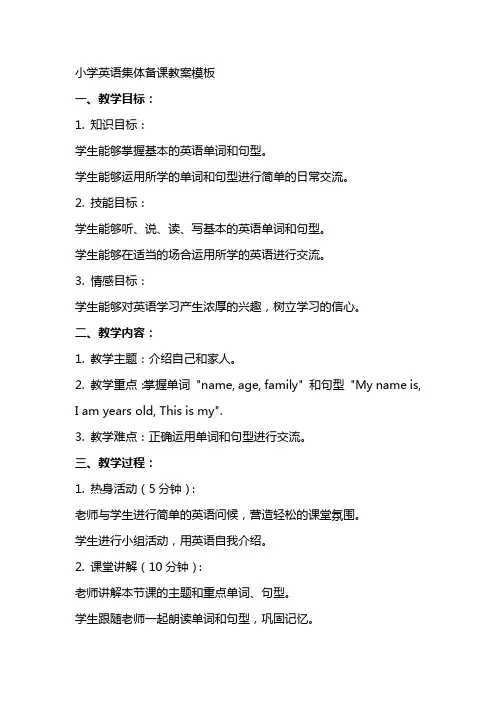
小学英语集体备课教案模板一、教学目标:1. 知识目标:学生能够掌握基本的英语单词和句型。
学生能够运用所学的单词和句型进行简单的日常交流。
2. 技能目标:学生能够听、说、读、写基本的英语单词和句型。
学生能够在适当的场合运用所学的英语进行交流。
3. 情感目标:学生能够对英语学习产生浓厚的兴趣,树立学习的信心。
二、教学内容:1. 教学主题:介绍自己和家人。
2. 教学重点:掌握单词"name, age, family" 和句型"My name is,I am years old, This is my".3. 教学难点:正确运用单词和句型进行交流。
三、教学过程:1. 热身活动(5分钟):老师与学生进行简单的英语问候,营造轻松的课堂氛围。
学生进行小组活动,用英语自我介绍。
2. 课堂讲解(10分钟):老师讲解本节课的主题和重点单词、句型。
学生跟随老师一起朗读单词和句型,巩固记忆。
3. 小组活动(10分钟):学生分组进行角色扮演,运用所学的单词和句型进行交流。
老师巡回指导,纠正学生的发音和语法错误。
4. 课堂练习(5分钟):学生完成课后练习题,巩固所学知识。
老师及时批改,给予学生反馈。
5. 总结与作业布置(5分钟):老师对本节课的内容进行总结,强调重点。
布置作业,要求学生复习所学知识,并练习运用。
四、教学评价:1. 课堂参与度:观察学生在课堂上的积极参与程度,以及与老师和同学的互动。
2. 发音准确性:检查学生在朗读单词和句型时的发音准确性。
3. 作业完成情况:检查学生对课后练习的完成情况,以及对所学知识的掌握程度。
五、教学资源:1. 教学课件:用于展示单词和句型,直观地引导学生学习。
2. 练习题:用于巩固所学知识,及时检查学生的学习效果。
3. 录音机或音响:用于播放英语歌曲或听力材料,增加学生的听觉学习效果。
4. 教学卡片:用于进行小组活动,方便学生进行角色扮演。
六、教学策略:1. 任务型教学法:通过小组活动和小任务,引导学生主动参与课堂,提高学生的实际运用能力。
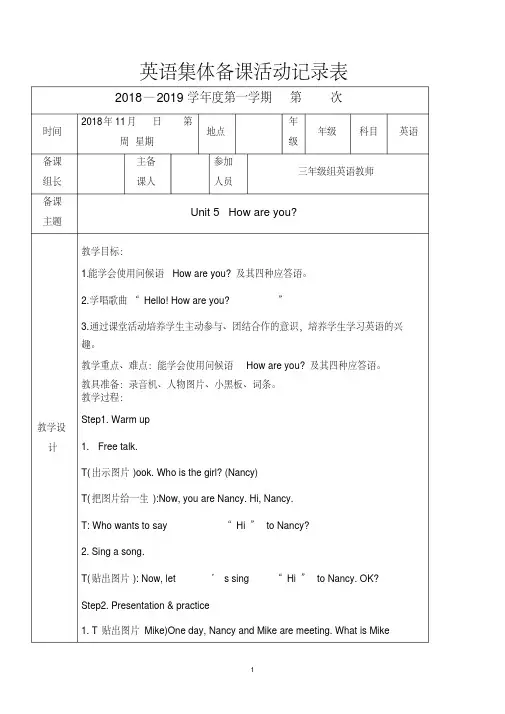
英语集体备课活动记录表2018—2019学年度第一学期第次时间2018年11月日第周星期地点年级年级科目英语备课组长主备课人参加人员三年级组英语教师备课主题Unit 5 How are you?教学设计教学目标:1.能学会使用问候语How are you?及其四种应答语。
2.学唱歌曲“Hello! How are you?”3.通过课堂活动培养学生主动参与、团结合作的意识,培养学生学习英语的兴趣。
教学重点、难点:能学会使用问候语How are you?及其四种应答语。
教具准备:录音机、人物图片、小黑板、词条。
教学过程:Step1. Warm up1. Free talk.T(出示图片)ook. Who is the girl? (Nancy)T(把图片给一生):Now, you are Nancy. Hi, Nancy.T: Who wants to say “Hi” to Nancy?2. Sing a song.T(贴出图片): Now, let’s sing “Hi” to Nancy. OK?Step2. Presentation & practice1. T贴出图片Mike)One day, Nancy and Mike are meeting. What is Mikesaying? Listen.播放两遍录音。
T: Who can tell me? (出示:How are you? ) 领读句子。
T:Mike says “How are you?” What is Nancy saying? Listen.播放两遍录音。
指名说听到的句子。
(出示:Fine, thank you. )领读句子。
看板书,听老师说chant。
跟老师说chant。
齐说。
2. T:Now, let’s play a train game.T教师示范游戏规则)The first row please stand up and turn round. Thensay “How are you?” one by one.师生问答。
小学英语下册集体备课活动记录范文全文共3篇示例,供读者参考篇1Collective Lesson Planning Activity RecordToday was the last day before our spring break, but we had an important collective lesson planning session for the second semester English textbook. All the sixth grade English teachers and a few students from each class gathered in the media room after classes ended.Ms. Lee, the head English teacher, started the meeting by welcoming everyone. "Thank you all for coming today to discuss the new textbook and plan activities for the second semester. We want to make sure the lessons are engaging and the students can build solid English skills."She then introduced the new textbook series we would be using called "Explorers". It had ten units focused on different themes like animals, traveling, technology, and more. Each unit had reading passages, grammar exercises, writing activities, and listening components.Next, the teachers discussed the overall goals and curriculum standards we needed to cover related to reading comprehension, vocabulary acquisition, grammar skills, writing abilities, and oral communication. They went over strategies for differentiated instruction to support students at different levels.After that overview, we split into small groups with a few teachers and students in each group. We focused on planning activities and materials for the first three units.My group looked at Unit 1 about different animals around the world. One of the teachers, Mr. Wang, said we should start with some engaging realia, like stuffed animal toys orpictures/videos of animals.Lily, a student in my group, suggested having students survey the class about their favorite animals first. "We could tally the results and graph the data on the board," she said. "That would get everyone interested and using English."Ms. Chen agreed, "Great idea, Lily. We can integrate that math and data skill while naturally using animal vocabulary."For the main reading passages, the teachers wanted to include extension activities beyond just comprehension questions. They proposed ideas like creating dioramas ofdifferent habitats, or writing acrostic poems using vocabulary words.Zhang Li, another student, raised his hand. "I think it would be fun to do group projects researching our favorite real animals and then presenting to the class. We could make posters and videos to share what we learned.""Excellent suggestion," Mr. Wang replied. "That would be a creative way to have students apply their reading, writing, and speaking skills in an engaging way."The teachers also discussed ways to spiral review previously-learned grammar concepts and vocabulary throughout the unit activities. They stressed the importance of plentiful comprehensible input through reading, listening, visuals, and interaction.For Unit 2 about family and home life, another group suggested hands-on activities like creating family tree projects with photos and descriptions. They planned ways for students to interview relatives to practice language in authentic situations. There was also an idea for a "Dream House" writing piece where students could get creative.The group for Unit 3, which focused on transportation and travel, proposed taking a virtual field trip around the world using video tools. Students could research modes of transportation in different countries and cultures. There were also ideas for journal writing activities about imaginary vacations.Throughout the discussions, the teachers made sure to incorporate the"5C" principles of communication, cultures, connections, comparisons, and communities from the national standards. They wanted the activities to blend all four language skills in an integrated way.As each group shared their unit plans, we took diligent notes about the creative ideas to try in our own classes. The veteran teachers offered invaluable experience, while we students provided our perspectives on what resonates as engaging.Towards the end, Ms. Lee reminded us of helpful online resources for supplemental materials, articles, videos, games and more. She said they would compile everyone's ideas to create a sharable curriculum roadmap before next semester.Finally, Ms. Lee expressed her appreciation to the students for our input and insights that would help shape the coming units. "You are the learners we aim to engage, so your voices areincredibly valuable as we collaboratively plan meaningful activities."As the meeting wrapped up, I felt excited andmotivated for the new semester ahead. Working together, we had generated a rich array of culturally authentic, student-centered activities to bring the textbook to life. With such careful planning and creative ideas, I knew we would be set up for an enriching English learning experience.篇2Collective Lesson Planning: English Textbook (Second Semester)Today was our monthly collective lesson planning session for the second semester English textbook. I always look forward to these meetings because it gives us students a chance to share our thoughts and have input on how the lessons will be taught. Mrs. Roberts, our English teacher, really values our feedback.We started off by reviewing the key objectives and vocabulary for each unit in the second half of the textbook. There are four units left to cover: Unit 6 Daily Routines, Unit 7 Describing People and Things, Unit 8 Popular Cultures and Hobbies, and Unit 9 Our Diverse Communities.For Unit 6 on daily routines, we suggested incorporating more interactive activities to practice the vocabulary and verb tenses for talking about our schedules. Maybe we could do role plays where we interview each other about our typical day. Or we could create picture prompts showing people doing different activities and describe their routines.Noah raised his hand and said he wished we could watch some video clips modelling common daily routines from different cultures. That's a fantastic idea! Seeing authentic examples from real life would make the language much more meaningful. Mrs. Roberts said she'd look for some appropriate videos to supplement the textbook content.When we got to Unit 7 on describing people and things, Emma suggested we could bring in some household objects or family photos to describe using the new adjectives. Getting to apply the language to real objects we care about would definitely make it more engaging and memorable. We could even have a classroom "show and tell" day.Unit 8 on popular culture and hobbies is one I'm particularly excited about. We've been studying so much academic vocabulary – it will be fun to learn the words for our favorite movies, music, games and activities. Jayden proposed that eachof us could give a short presentation about our biggest passion or hobby. I'm already thinking about how I could teach the class some cool dance moves from my favorite K-pop music videos!Several students pointed out that the dialogues in the textbook for this unit seem a bit unnatural and outdated when talking about trends. We asked if maybe Mrs. Roberts could invite some older students to join one of our classes as guest speakers to discuss current popular interests. Getting perspectives from students closer to teenage culture would provide much more relevant, authentic language exposure.For the final Unit 9 about communities and cultural diversity, the class agreed it was crucial to include lessons highlighting the many ethnic and cultural backgrounds represented in our town and school. We definitely shouldn't just learn about mainstream American customs and values.Amelia's mom is Hispanic, so Amelia volunteered to guide us in some basic Spanish greetings and phrases. Maybe we could also sample traditional foods from various cultures. I know I'd love to try making some delicious ethnic dishes to share with my classmates! Hands-on activities celebrating our diversity would be so much more meaningful than just reading from the textbook.Toward the end of our meeting, Isaac asked if we could get some students' thoughts on making the units more interactive and personalized for English language learners in our class. He pointed out that while speaking activities allow students to practice, some need more differentiated support such as visuals, translation dictionaries, or sentence frames. Mrs. Roberts agreed that was an excellent suggestion to be inclusive of all learners' needs.As we were wrapping up, Mrs. Roberts thanked everyone for their insightful ideas about how to adapt the lessons to our interests and learning styles. She said she would incorporate as much of our feedback as possible when mapping out her daily instructional plans. I could tell she was really grateful for our input—it's just one example of how ourschool values student voice.I'm really looking forward to English class next semester! Thanks to our collaborative planning efforts, the units won't just be a dry reading from the textbook. Instead, the lessons will be customized for our class with engaging projects, authentic texts, hands-on activities, and connections to our personal lives. What a great way to make learning English fun and relevant!篇3English Collective Lesson Planning: A Fun Adventure!Last week, our English teacher Ms. Roberts announced that we would be having a special "collective lesson planning" activity for the second half of our English textbook. I wasn't sure what that meant, but it sounded exciting!When we arrived at school on Monday morning, Ms. Roberts had rearranged the desks into groups of four. She explained that each group would be responsible for planning and teaching one lesson from our new English book to the rest of the class. We could be as creative as we wanted with activities, games, props, and more.My group consisted of my best friends Jake, Emma, and Sophia. We did a little happy dance when Ms. Roberts assigned us Chapter 8 - "A Day at the Zoo." We all love animals, so this was the perfect topic for us.First up, we read through the chapter thoroughly, taking notes on the main vocabulary words, grammar points, and learning objectives. There were words like "elephant," "giraffe," "tickets," and "map." The grammar focused on using prepositions of place, like "The monkey is in the tree."Once we identified the key elements, it was time to start planning our lesson activities. Emma suggested creating animal masks that students could wear and act out. Sophia had the brilliant idea of transforming our classroom into a zoo using brown paper bag Animal exhibits. Jake was insistent that we incorporate some kind of physical game too.Over the next few days, we worked tirelessly as a team to bring our vision to life. We made elephant masks out of gray construction paper, complete with fabric trunks that could wiggle back and forth. Emma's mom is an artist, so she helped paint amazing backgrounds on large cardboard boxes to recrecreate zebras, snakes, and flamingo habitats.For the game component, we decided to play an animated version of "Zoo Bingo." Jake found some fun animal sound effect downloads and burned them onto a CD. During the game, he would play an animal noise, and students had to quickly find and mark off that animal on their Bingo boards.Finally, the big day arrived! We excitedly set up our makeshift zoo exhibits around the classroom. Ms. Roberts allowed us to borrow a portable CD player for the sounds. We could hardly contain our enthusiasm as we welcomed our classmates and handed out the elephant masks.Jake bravely took the lead, introducing the lesson objectives and vocabulary using a PowerPoint slideshow. Then it was time for the first activity - an animated story time. We all wore our masks, acting out the different scenes while Ms. Roberts read aloud from the textbook. The elephant masks were a huge hit, with trunks swinging gleefully.Next up was the Zoo Bingo game. Jake took his DJ position behind the CD player, cuing up each animal roar, howl, or tweet. You could feel the tension and excitement as students raced to dab their Bingo cards. Sophia was the Bingo caller, double checking each winning board.For the final activity, we split the class into small groups to create their own animal habitats using our paper bag zoo exhibits as inspiration. Emma and I floated between the groups, offering encouragement and assistance. The creativity on display was outstanding, from a family of foxes to a deep sea aquarium.When it was all over, we received a roaring round of applause from our thankful classmates. Ms. Roberts beamed with pride, praising our innovative lesson and seamless teamwork. "You all are an inspiration," she told us. "This is what learning should look like - creative, engaging, and fun!"Looking back on our collective lesson planning adventure, I'm filled with a sense of accomplishment. We took an ordinary textbook chapter and transformed it into an extraordinary educational experience. We developed valuable skills like collaboration, problem-solving, and public speaking. Most importantly, we made learning English enjoyable and memorable for everyone involved.I can't wait for our next collective lesson planning opportunity. Teaching is hard work, but it's also incredibly rewarding. One thing is for sure - our class will never look at elephants, zebras, and snakes the same way again!。
一、教案基本信息1. 课题名称:小学英语集体备课教案模板2. 教材版本:人教版PEP小学英语3. 年级段:三年级4. 课时安排:2课时5. 教学目标:a. 让学生掌握基本的英语单词和句型b. 培养学生的听说读写能力c. 提高学生团队合作意识二、教学内容1. 单词:hello, good morning, good afternoon, good evening, how are you, I'm fine, thank you, you're wele, good e2. 句型:介绍自己,询问他人,回答问候三、教学过程1. 课前准备:教师提前准备好单词卡片和句型练习册2. 第一课时:a. 热身活动:唱英文歌《Hello》b. 教学新单词:通过单词卡片,让学生逐个学习和朗读单词c. 句型练习:让学生分组,用新学的单词和句型进行对话练习d. 课堂小结:教师总结本节课所学内容3. 第二课时:a. 复习:通过复习单词卡片和句型练习册,巩固所学知识b. 情景剧:让学生分组,用所学单词和句型编写小剧本并进行表演c. 拓展活动:让学生用英语进行自我介绍,锻炼口语表达能力d. 课堂小结:教师总结本节课所学内容四、作业布置1. 抄写新学的单词和句型2. 回家后与家长用英语进行自我介绍五、教学反思1. 教师在课后要对课堂教学进行反思,观察学生的学习效果,发现问题并及时调整教学方法2. 对于学习有困难的学生,教师要进行个别辅导,提高他们的学习兴趣和自信心3. 定期组织家长会议,与家长沟通交流,共同关注学生的学习进步六、教学评价1. 采用课堂表现、作业完成情况、情景剧表演等多方面进行评价2. 关注学生的听说读写能力,鼓励学生积极参与课堂活动,提高课堂互动性3. 定期进行单元测试,检查学生对单词和句型的掌握情况七、教学资源1. 单词卡片2. 句型练习册3. 英文歌曲《Hello》4. 情景剧剧本模板5. 单元测试卷八、教学难点1. 学生对单词的拼写和记忆2. 学生对句型的运用和表达3. 学生英语口语的流畅性和准确性九、教学策略1. 采用直观教学法,通过单词卡片和句型练习册,帮助学生直观地学习和记忆单词和句型2. 采用情景教学法,让学生在实际情境中运用所学知识,提高学生的实际运用能力3. 采用分组合作学习,提高学生的团队合作意识和沟通能力十、课后服务1. 为学生提供课后辅导服务,针对学习有困难的学生进行个别辅导3. 组织英语角活动,让学生有更多的机会练习英语,提高学生的英语水平十一、教学拓展1. 组织英语角活动,让学生在轻松愉快的氛围中练习英语口语。
PEP小学英语四年级下册单元集体备课记录;;教材分析;本部分知识重点复习学校各功能室的名称,时间的表达及衣服的名称及单复数形式。
及指示代词引导的陈述性的句子This/Thatis…和一般疑问句Isthisyour…?Yes,itis./No,itisn’t./No,it’snot..These/Thosea re…还有询问时间的句子Whattimeisit?It’s…教材编写者巧妙的把这些知识融合在活动、歌谣、歌曲及故事中。
根据各部分的联系,我把本复习单元分成下列三课时。
课时安排。
第一课时Taskt imeLet’sfindoutThinkandwrite第二课时ReadandactLet’ssing第三课时Let’sreadChantandwrite四下Recycle1(第一课时)教学内容TasktimeLet’sfindoutThinkandwrite教学目标1.能够用废旧物品设计衣服,并且能够用简单的英语介绍。
2.能够掌握好一、三单元的词汇。
3.能够完成Let’sfindout.Thinkandwrite.4.能够在制作衣服的过程中听懂和学会说下列词汇:newspaper,afa shionshow,It’sverypretty/beautiful.为下一节课的Readandact做好铺垫。
(Readandact中的新词和句子太多)教学重点。
1.一、三单元的四会单词的正确书写和在情景中运用。
2.通过制作衣服复习衣服的名称。
教学难点在展示中正确使用所学语言教学准备报纸、杂志、纸板盒以及布条等废旧物,胶水、剪刀、彩笔等工具教学过程。
一Preparation1.教师播放第三单元的歌曲“Myclothes.”(师学生进一步熟悉所学过的有关服装的单词,为下一步的学习做好铺垫。
)2.快看快拼单词,把衣服和课程单词卡片呈现给学生,让学生分两大组快拼比赛。
二、Presentation1.方法(1)教师把自己事先做好的服装展示出来。
20PP-20PP第二学期英语组集体备课记录时间: 20PP-2-24地点:大会议室人员:英语组全体成员主讲人:郑委记录人:张艳课题:4B《Unit2AtapartP》教材简析:教者讲的是4BUnit2AtapartP的第二课时。
本单元的主要话题是“根据特征认人”。
“认人”是在第一单元所学句型Who’sthat…?He’s/She’s…基础上进行的拓展练习。
教师将本课的教学内容定为在复习B部分单词的基础上学习A 部分对话。
整堂课采用照片、玩具、图片展开教学。
做到“字不离词,词不离句,句不离篇”。
以情感培育人,以兴趣吸引人,通过引导学生参与对话,说儿歌、唱英文歌曲等丰富多彩的教学活动,营造一种轻松愉快的教学氛围,让学生充满乐趣地学习,并在自主学习的成功体验中进一步提高学习英语的兴趣和积极性。
根据学生的认知规律,我将本课的重难点定为四会掌握句型Who’sthe…with(i n)…?He’s/She’s….Whichone?Theonein/with….研讨记录:陶文月老师:本节课的教学设计,设计的很合理,思路清晰明了,值得我们学习。
每个步骤之间,串联的很自然,给人感觉比较流畅,符合了教学设计应该走中心线的这个理念。
当教授完新的知识后,又能设计与其相对应的练习,让学生巩固新知识,这在教学过程中是非常有帮助的。
成志薇老师:本节课的内容设计新颖,合理,思路清晰,教学目标明确,重难点突出,能充分反映出本课所教内容的重点,也能抓住主要内容进行教学。
教与练的结合,可以让学生更牢固地掌握新知。
冯娅老师:本单元情景的创设真实可信,能激发学生参与学习活动的热情。
教者关注学生学会归纳小结的能力,因为对于四年级的学生来说,他们应该具备此方面的能力,这样会为他们的后继学习带来无限的生命力。
张艳老师:本教案教学目标明确,重点突出。
教学设计思路清晰合理,从整个教学过程来看每个环节都很紧凑,衔接也比较自然。
板书设计也比较合理。
小学英语三四年级英语集体备课活动记录表(14节)本次教学的目标是让学生掌握本单元的词汇和句型,并能够在实际交流中运用。
同时,培养学生的口语表达能力,提高英语听说读写综合能力。
三、教学重难点:本次教学的重点是让学生掌握本单元的词汇和句型,难点在于如何让学生在实际交流中运用所学内容。
四、教学方法:本次教学将采用多种教学方法,包括情景教学法、直接教学法和TPR全身反应法等,同时结合游戏和活动,让学生在轻松愉悦的氛围中研究英语。
五、教学步骤:1.复上节课所学内容,包括单词和句型。
2.引入新词汇,让学生掌握新单词的发音、意义和用法。
3.引入新句型,让学生掌握句型的用法和常见场景。
4.进行口语练,让学生在实际情境中运用所学内容。
5.进行听力训练,让学生能够听懂并理解所学内容。
6.进行阅读训练,让学生能够读懂并理解所学内容。
7.进行写作训练,让学生能够用所学内容进行简单的书写练。
8.进行游戏和活动,让学生在轻松愉悦的氛围中巩固所学内容。
六、教学反思:本次教学采用了多种教学方法,让学生在轻松愉悦的氛围中研究英语。
但在口语练和写作训练中,部分学生表现不佳,需要在后续的教学中加强练。
同时,还需注重学生的听力训练,提高学生的听力理解能力。
能够听、说、认读和拼写go。
buy。
have。
watch。
listen这五个单词。
在教学过程中,教师应该鼓励学生动脑筋,巧妙记忆这些单词,并能够说出相关的词组,通过情景研究新单词,从而能够灵活运用这些单词。
2)本课的重点是Vocabulary部分的四会单词。
教师应该启发学生开动脑筋,巧妙记忆单词,并能够说出相关的词组,在情景中研究新单词,从而能够灵活运用这些单词。
同时,教师应该让学生熟练掌握句式Can I have a balloon。
please。
并能够在实际交际中运用。
在进行英语教学时,语言基本功训练是非常重要的。
教师应该结合句式转换,进行机械操练,使学生熟悉其结构形式,形成条件反射,以便不加思索地运用,达到语感敏锐、反应快捷、脱口而出的效果。
新人教版pep小学三年级英语集体备课记录PEP小学三年级英语集体备课记录课题:Unit 4 We Love Animals一)知识目标第二课时1.使学生能够听、说、认读本课时主要单词:monkey。
dog。
duck。
cat。
panda。
rabbit。
2.能够听懂简单的指示语,并按照指令做出相应的动作,如:Act XXX。
二)能力目标提高学生听、说、认读、做的综合能力。
三)情感与策略目标培养学生乐于模仿,敢于开口,积极参与,主动请求的情感态度;激发学生热爱动物,保护自然环境的思想意识;并使学生在小组活动中培养合作意识和竞争意识。
教学目标:教学要点:1.重点:能够听、说、认读六个有关动物的单词。
2.难点:能将这六个有关动物的单词运用到简单的英语句子中表达。
教学准备:单词卡片,动物图片,小动物毛绒玩具,多媒体课件等。
教学过程:教师调控:正式上课之前,老师向听课教师及学生介绍本节课的分组情况,T: 同学们,今天我们一共有八个小组,team1 to team8,我们来比一比哪个小组最棒,好不好?1.GreetingsT: Class begin。
stand up。
Good morning。
morning。
Ss。
Good morning。
XXX: Sit down。
please。
Thank you!2.XXX(歌曲开篇,引入情境)T: 现在又要和网络课堂的小朋友们一起学英语了,Areyou happy。
学生回答 Yes。
后(板书课题)T: OK。
let’s go!(伴有手势)Let’s go。
T: First。
let’XXX(播放网络课堂的视频,师生一起跟唱并做动作) Sing and do!T: After it。
let’XXX.(继续观看网络视频)二。
XXX1.T: 同学们要注意都看到了哪些小动物?(观看小动物游行队伍的网络视频)2.T: Now。
let’s learn some new words。
(出示单词卡片) Look。
2008-2009第二学期英语组集体备课记录时间: 2009-2-24地点: 大会议室人员: 英语组全体成员主讲人: 郑委记录人: 张艳课题:4B《Unit 2 At a party》教材简析:教者讲的是4B Unit 2 At a party的第二课时。
本单元的主要话题是“根据特征认人”。
“认人”是在第一单元所学句型Who’s that…? He’s/She’s…基础上进行的拓展练习。
教师将本课的教学内容定为在复习B部分单词的基础上学习A部分对话。
整堂课采用照片、玩具、图片展开教学。
做到“字不离词,词不离句,句不离篇”。
以情感培育人,以兴趣吸引人,通过引导学生参与对话,说儿歌、唱英文歌曲等丰富多彩的教学活动,营造一种轻松愉快的教学氛围,让学生充满乐趣地学习,并在自主学习的成功体验中进一步提高学习英语的兴趣和积极性。
根据学生的认知规律,我将本课的重难点定为四会掌握句型Wh o’s the…with (in)…? He’s/ She’s…. Which one? The one in/ w ith….研讨记录:陶文月老师:本节课的教学设计,设计的很合理,思路清晰明了,值得我们学习。
每个步骤之间,串联的很自然,给人感觉比较流畅,符合了教学设计应该走中心线的这个理念。
当教授完新的知识后,又能设计与其相对应的练习,让学生巩固新知识,这在教学过程中是非常有帮助的。
成志薇老师:本节课的内容设计新颖,合理,思路清晰,教学目标明确,重难点突出,能充分反映出本课所教内容的重点,也能抓住主要内容进行教学。
教与练的结合,可以让学生更牢固地掌握新知。
冯娅老师:本单元情景的创设真实可信,能激发学生参与学习活动的热情。
教者关注学生学会归纳小结的能力,因为对于四年级的学生来说,他们应该具备此方面的能力,这样会为他们的后继学习带来无限的生命力。
张艳老师:本教案教学目标明确,重点突出。
教学设计思路清晰合理,从整个教学过程来看每个环节都很紧凑,衔接也比较自然。
板书设计也比较合理。
时间: 2009-3-16地点: 大会议室人员: 英语组全体成员主讲人: 冯娅记录人: 张艳课题:5B 《Unit 3 Hobbies》教材简析:本单元围绕“兴趣爱好”这个话题开展教学活动。
主要是学习一般疑问句Do you have any hobbies? 及其答语Yes,I do. /No, I don’t.和主语为第三人称单数动词的用法。
本节课是本单元的重点,通过学习初步领会第三人称单数动词和第一人称单数动词的区别。
同时通过课文重点句子的学习,听得懂、会说、会读课文,进一步提高学生听、说、读、写综合素质能力。
教学目标:(1)认知目标:能进一步掌握本单元所学的有关兴趣爱好的词汇:take pho tos ,go shopping ,collect stamps, grow flowers, make model ships ,make clothes 。
能用He/She likes... 的句型描述他人的爱好和活动。
了解主语为第三人称单数时动词的变化形式。
正确的理解课文内容,并能朗读,表演对话。
能演唱本文的英语歌曲。
(2)能力目标:提高学生听、说、读、写及通过网络自学的综合能力。
(3)德育目标:通过学习本文,让学生知道良好的兴趣爱好能拓展知识,并能丰富一个人的生活。
研讨记录:刘玥老师:这堂课的安排,教者利用网络,针对五年级的教材特点和学生喜欢电脑的特点,遵循教学内容以任务驱动为模式而设计的。
我们知道,如果课堂上只是简单的知识传递和枯燥的机械性操练,学生是很难引起兴趣的。
所以教者在任务的安排上更多的是倾向于学生的自主性学习,开阔了学生的视野。
郑委老师:本节课教学内容较多,涵盖了part A/B/C三大块的知识点,并且B部分的词组都比较难于掌握,因此在读音方面应引起重视,要让学生在课前做好必要的预习工作,唯有如此,上课的教学活动才会畅通无。
成志薇老师:本单元情景的创设真实可信,能激发学生参与学习活动的热情。
教者关注学生学会归纳小结的能力,因为对于五年级的学生来说,他们应该具备此方面的能力,这样会为他们的后继学习带来无限的生命力。
陶文月老师:蔡老师充分利用网络来创设情境和开阔视野,并开展小组讨论的形式,考虑到了师生互动,生生互动和人机互动。
通过感知、体验,实践、参与和合作的方式,让学生在愉快的氛围中学习。
时间: 2009-3-20地点: 大会议室人员: 英语组全体成员主讲人: 张艳记录人: 成志薇课题:6B《 Unit 5 The seasons》教材简析:本课是牛津小学英语六年级下学期(6B)中的Unit 5 The seasons第二课时的教学内容。
本课的核心内容是“季节”。
所涉及的主要句型有: Which se ason do you like best? I like… Why? Because it’s … I can…本课主要学习四会单词:spring, summer, autumn, winter. 三会单词:best, because日常交际用语:Which season do you like best? I like… Why? Because it’s … I can…本课内容比较贴近学生的实际生活,语言运用情景也比较真实。
教学目标:1、认知目标:通过学习,使学生掌握四会单词:spring, summer, autumn, wi nter.掌握日常交际用语:Which season do you like best? I like… Why? B ecause it’s … I can…2、能力目标:通过“互动型”的教学途径,培养学生的创新精神和将所学的英语运用于日常交际的能力,提高学生的语言能力和学习能力,让学生得到自我发展和个性发展。
3、情意目标:通过创新教学方法,提高学生学习英语的兴趣;结合学习内容,培养学生的表现力,养成学生爱思考的良好习惯。
教学重难点:1、能掌握四个表示季节的单词,能正确表达季节。
2、能听懂、会说、会读句子:Which season do you like best? I like… W hy? Because it’s… I can…,并能正确、熟练地运用。
研讨记录:刘玥老师:教者在注重课堂活动知识容量大之基础的同时,一定要有一个主要的交际语言贯彻课堂活动的始终,千万不可本末倒置。
如:What’s the weather like in Liyang in spring/summer/autumn/winter?It’s …most of the time, sometimes it’s …这一交际用语,学生应该明白并会加以运用。
成志薇老师:教者让知识面尽可能扩展,要纵、横面相结合,既关注了全体学生的接受能力,还能让接受能力快的学生有新鲜的知识介入,从而让每个学生都有兴趣参与语言交际活动,促进学生各方面的成长。
陶文月老师:本节课的内容设计非常新颖,合理,思路清晰,能充分反映出本课所教内容的重点,也能抓住主要内容进行教学。
教学连接也非常自然流畅,一定量的练习又能对所学知识进行巩固。
郑委老师:对六年级学生来讲,知识容量大,教者能充盈课堂学习活动,满足学生的个体需要。
而且关注了课堂基本的语言交际,在此基础之上进行了必要的拓展,使学生学得更加扎实牢靠。
时间: 2009-4-3地点: 大会议室人员: 英语组全体成员主讲人: 陶文月记录人: 郑委课题:3B《 Unit 5 Plus and minus》教材简析:本课是本单元的第一课时,教学内容主要是在复习数词1—12基础上继续学习数词13—20,以及20以内的加法。
对于句型What’s …plus …? 回答It’s …评价That’s right./Sorry, you are wrong.要求学生理解,并能用以配合数词操练。
教学目标:1.能听懂、会说数词13—20。
2.能熟练掌握What’s …plus…? 及其回答It’s …并能用That’s right. / Sorry, you are wro等作出评价。
教学重难点:1.能听懂、会说数词13—20。
重点掌握数词13,15 和20 的正确读音。
2.能熟练掌握What’s ……plus /minus …? 及其回答It’s …并能用That’s right./Sorry, you are wrong.等作出评价。
研讨记录:郑委老师:如何让枯燥的数学计算What’s plus / mius ?有趣化,教者能让学生主体参与到课堂中来,尽量多运用各种游戏来激发学生的兴趣,让学生一直保持爱英语的好习惯,这一点非常值得学习。
刘玥老师:学生能在熟练掌握1—10 的基础上,学会13—19的数字,并掌握其变化规律。
教者通过各种方式引出数字,吸引了学生的眼球,从而达到掌握的目的。
冯娅老师:从课堂上学生反映的情况来看,学生学得还不错,不仅主动积极地开口交流,学生也学得很愉快。
教者能够有序的控制好活动秩序,达到了教学的目的。
张艳老师:在教学句型时,教者能创设各种情境,运用多媒体,图片等多种形式来教学,让学生在每次活动过程中都得到练习。
真正掌握了数词13-20,以及20以内的加法。
让学生能活学活用,举一反三,综合运用了语言,效果很好。
时间: 2009-5-8地点: 大会议室人员: 英语组全体成员主讲人: 陶文月记录人: 冯娅课题:3B《Unit7 Where》教材简析:牛津小学英语3B教材的第7单元中主要安排了“询问地点”的日常交际用语以及6个表示居室的单词。
日常交际用语主要包括Where’s…? It’s/He’s /She’s….要求学生能在理解的基础上熟练运用。
6个单词分别是a dining-r oom,a bedroom, a study, a kitchen, a bathroom, a sitting-room。
要求学生能够听懂、会说、会读这6个单词。
教学目标:1、能听懂、会说、会读表示居室的单词a dining-room,a bedroom,a study,a kitchen,a bathroom,a sitting-room。
2、能听懂、会说、会读日常交际用语Where’s the…? It’s in/on the….能较熟练地运用。
研讨记录:冯娅老师:本教案教学目标明确,重点突出。
教学设计思路清晰合理,从整个教学过程来看每个环节都很紧凑,衔接也比较自然。
板书设计也比较合理。
教学过程中还运用了多种形式和方法来教授单词和句型,内容比较多但不枯燥,学生能在轻松愉快的环境中得到较好的操练,从而达到预计的教学效果。
特别是where's the cake? it's in the fridge.的设计不错。